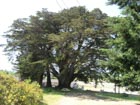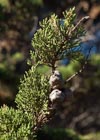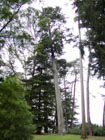
A relatively large tree in habitat, at Point Lobos, California [C.J. Earle, 2014.01.18].

The largest tree in Oregon, in Chetco; planted here by Harrison Blake in the 1850's, it had a dbh of 330 cm and height of 30.2 m in 2003 [C.J. Earle, 2009.06.19].

Foliage and mature cones on a tree in habitat, Point Lobos, California [C.J. Earle, 2014.01.18].

The trees at Point Lobos grow right down to the ocean's shore, and most are strongly shaped by wind and salt spray [C.J. Earle, 2014.01.18].

The species is called simply "macrocarpa" in New Zealand, where the largest known specimen occurs; this one is in Yatton Park, Tauranga [C.J. Earle, 2003.03.02].

A very large multiple-trunk tree, in Awaroa, New Zealand [Brad Cadwallader, 2008.07.21].

I was just driving along on the C405 through an industrial forest in Tasmania when I found this giant macrocarpa. There was no evidence of why or when it came to be planted by this lonely dirt road in the bush [C.J. Earle, 2015.03.04].

Conservation Status

Hesperocyparis macrocarpa
(Hartw.) Bartel (2009)
Common names
Monterey cypress, ciprés Monterrey (Eckenwalder 1993).
Taxonomic notes
Synonymy: see POWO (accessed 2023.12.16). Callitropsis nootkatensis in cultivation has spontaneously hybridized with C. macrocarpa. The hybrid is the Leyland cypress, x Hesperotropsis leylandii; see POWO (accessed 2023.12.16) for its synonymy.
Description
"Trees to 25 m; crown generally broadly spreading, especially on exposed headlands, fairly sparse, often composed of few major limbs from near ground, more upright in sheltered locations. Bark rough, fibrous. Branchlets decussate, 1.5-2 mm diam. Leaves without gland or sometimes with inconspicuous, shallow, pitlike, abaxial gland that does not produce drop of resin, not glaucous. Pollen cones 4-6 × 2.5-3 mm; pollen sacs 6-10. Seed cones oblong, 2.5-4 cm, grayish brown, not glaucous; scales 4-6 pairs, smooth, umbo nearly flat at maturity. Seeds mostly 5-6 mm, dark brown, not glaucous. 2n = 22" (Eckenwalder 1993). See García Esteban et al. (2004) for a detailed characterization of the wood anatomy.
Distribution and Ecology
USA: California: the Pacific Coast at Carmel (near Monterey), in two groves, at Cypress Point and Point Lobos (Peattie 1950). See also Thompson et al. (1999). Due to its rarity, it is of conservation concern. It is known from fossils to have been in other regions. It is much planted and commonly naturalized near the coast from central California north to Washington and in warm temperate and subtropical regions worldwide (Eckenwalder 1993). Hardy to Zone 8 (cold hardiness limit between -12.1°C and -6.7°C) (Bannister and Neuner 2001).
Data from USGS (1999).
The species is moderately serotinous. It is normally dependent on fire in its coastal sage scrub habitat to cause opening of cones and dispersal of seeds, but some cones will open under conditions of moderate heat (such as on hot summer days) and some regeneration occurs in unburned habitat. However, fire suppression at Point Lobos is causing low regeneration and prescribed fire treatments will probably be necessary at some time to maintain a wide population age structure.
This species forms both single species and mixed stands. In the latter, its most common associate is another narrow endemic, the Monterey pine (Pinus radiata).
Remarkable Specimens
None of the largest trees occur in their native habitat. The largest in the US was remeasured in January 2015 and found to be 31.1 m tall, dbh 475.8 cm, with a 33.8 m crown spread. It grows in the valley of Pescadero Creek, E of Pescadero, California (Matt Ritter email 2015.01.11). A much taller tree (height 48 m, dbh 122 cm) occurs in San Francisco, California (American Forests 2000). The largest tree in Great Britain is 36 m tall, dbh 320 cm, in Strete Ralegh, Devon (Mitchell et al. 1990). Some of the largest trees are ornamentals in New Zealand, where the species has been popular since the 1850s. The largest tree there, identified and measured in 2012, is in Awhitu, south of Auckland. It is 23.8 m tall with a dbh of 463.1 cm and a crown spread of 29.5 m (Brad Cadwallader email 2012.04.14). Other very large trees can be found in Pukekura Park (IDS 1996), in Yatton Park, Tauranga (Burstall and Sale 1984), in Awaroa (photo at right; Brad Cadwallader email 2009.10.03), and in Brooklands Park, New Plymouth (Robert Van Pelt email 2009.04.14).
Jepson (1923) reports a maximum age of 284 years, but provides no details.
Ethnobotany
This is an extremely popular ornamental in the western U.S., the U.K., New Zealand, and some other areas with suitable climate. It often attains impressive sizes, and does so quickly. In New Zealand, where it is called simply "macrocarpa", it is also harvested for fine carpentry such as cabinetmaking and musical instruments. The hybrid with Calltropsis nootkatensis, Leyland cypress, is a spectacularly popular horticultural item in much of the temperate zone, with scores of described cultivars.
Observations
The species is widely planted as an ornamental in California and often elsewhere in North America and Europe. In its native range, it is abundant and easily seen at the Point Lobos State Reserve a few miles south of Monterey on State Route 1. A Web search will reveal much information about the Reserve.
Remarks
The species was collected, and seeds sent home to Europe, no later than 1838, when A.B. Lambert gave some seeds of unspecified provenance to the Horticultural Society. It went then by the horticultural name of Cupressus lambertiana, but was never formally described (Gordon 1849). The species was named by Theodor Hartweg, who collected it at Carmel Bay in July of 1846 (Hartweg 1847). Hartweg (1812-1871) was a German who spent 1845-1848 plant collecting in California at the behest of the Horticultural Society of London. Hartweg, like David Douglas, was a protege of William Jackson Hooker. He recounted his adventures in several issues of the Horticultural Society's Journal in 1847-1848 (here's an example). Hartweg had a highly productive career, collecting widely from 1836 to 1848 in Colombia, Ecuador, Guatemala, Jamaica, and Mexico, discovering many orchids and other remarkable plants. His later years were spent as director of the Swetingen Gardens in Baden, Germany. His work among the conifers is commemorated in the alpine pine of Mexico and Central America, Pinus hartwegii.
Citations
American Forests 2000. The National Register of Big Trees 2000. Washington, DC: American Forests.
Bartel 2009: described in Adams, R. P., J. A. Bartel and R. A. Price. 2009. A new genus, Hesperocyparis, for the cypresses of the western hemisphere. Phytologia 91(1):160-185.
Gordon, G. 1849. New plants, etc., from the Society's garden. 31. Cupressus macrocarpa. Journal of the Horticultural Society of London 4: 296-297. http://www.cupressus.net/CUmacrocarpaGordon.html, courtesy of the Cupressus Conservation Project website.
Hartweg, T. 1847. Journal of a mission to California in search of plants. Journal of the Horticultural Society of London 2: 187. http://www.cupressus.net/CUmacrocarpaHartweg.html, courtesy of the Cupressus Conservation Project website.
[IDS] International Dendrology Society Yearbook 1996, page 92.
Jepson, W. L. 1923. Monterey cypress. The Trees of California, ed. 2. http://www.cupressus.net/Jepson1923a.html, courtesy of the Cupressus Conservation Project website.
See also
Adams, R. P. and J. A. Bartel. 2009. Geographic variation in the leaf essential oils of Hesperocyparis (Cupressus) abramsiana, H. goveniana and H. macrocarpa: Systematic implications. Phytologia 91(1):226-243.
Elwes and Henry 1906-1913 at the Biodiversity Heritage Library. This series of volumes, privately printed, provides some of the most engaging descriptions of conifers ever published. Although they only treat species cultivated in the U.K. and Ireland, and the taxonomy is a bit dated, still these accounts are thorough, treating such topics as species description, range, varieties, exceptionally old or tall specimens, remarkable trees, and cultivation. Despite being over a century old, they are generally accurate, and are illustrated with some remarkable photographs and lithographs.
Farjon (2005) provides a detailed account, with illustrations.
Griffin and Critchfield (1972).
Notable Trees of New Zealand.
Threatened Conifers of the World.







